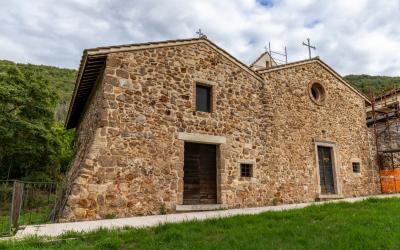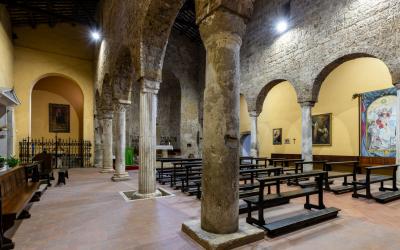Cosmatesque floors and Romanesque frescoes in the earth of Etruscan necropolises
Located in the center of a small medieval village that developed among the remains of the Etruscan Necropolis of Fonaci (11th-10th century BC), the Sanctuary of the Madonna dei Ceri preserves the relics of San Felice II (Pope from 355 to 357) and precious Cosmatesque floors. The oldest part of the Church is preserved only in the apse dating back to before the 14th century. The Romanesque frescoes decorate the nave with biblical scenes, particular kitchen scenes, fighting devils and a chimera.
The entrance to the small village of Ceri is through a typical Etruscan cut. The current fortified village was probably built on a tuff plateau by the inhabitants of Caere (now Cerveteri) in the 11th century who moved there, probably because of malaria or to better defend themselves during Saracen raids. Currently it is not possible to enter the village by car, which must be left in a large parking lot outside the monumental gate.
The Church of the Madonna di Ceri is located right at the entrance to the town. It is assumed that the structure of the church initially had three naves and a truss roof, with side slopes. This original structure was modified to accommodate the relics of San Felice II in 357 who, according to tradition, was relegated by the emperor Costanzo to Ceri "seventeen miles from Rome and there he suffered glorious martyrdom on 22 November 365". It is therefore a place of early Christian worship. To contain these relics, a rectangular aedicule was built in 1484, with four Ionic columns supporting the same number of arches. Thanks to recent restorations, it is possible to admire both the Cosmatesque floor and the interesting frescoes of the central nave inside the church.











